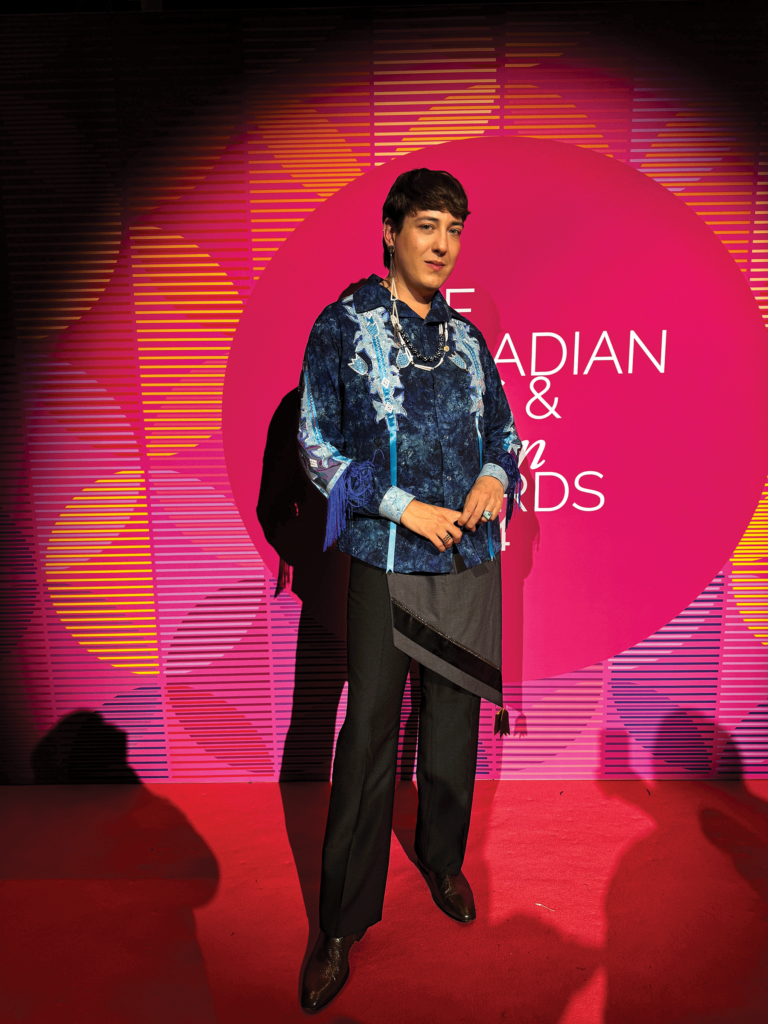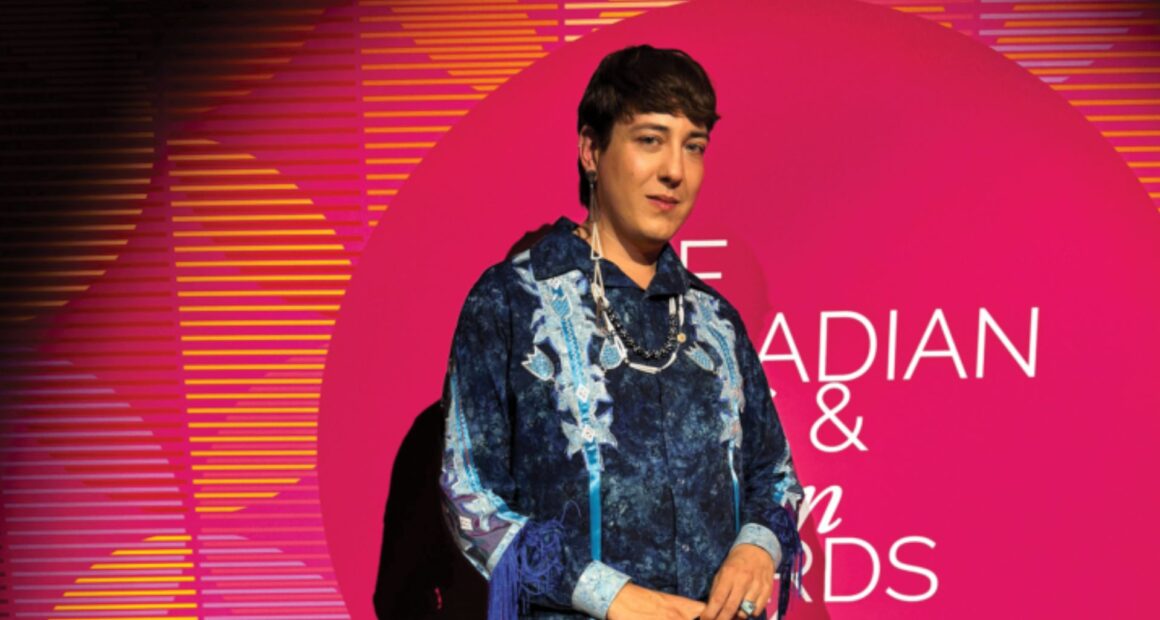Fashion magazines aren’t telling Indigenous stories—Vogue’s Christian Allaire is changing that

Photo: Courtesy Christian Allaire
On the first Monday in May, Christian Allaire, a senior fashion and style writer at Vogue, is up at seven in the morning writing stories in preparation for fashion’s biggest event. By the early afternoon, he is ready and ravishing on Fifth Avenue for the Met Gala’s 2024 red carpet, themed “The Garden of Time.” Allaire, descending from Italian-French and Ojibwe lineage, wears a black suit and blazer detailed with purple lupines and scarlet red Indian paintbrushes—the flowers from back home. His designer, Jamie Okuma, added a traditional black-and-white Ojibwe breechcloth to the pants, mixing the tailored, modern suit with traditional, cultural attire. To top it off, Allaire carries an antique, multicoloured shoulder bag with floral beadwork to represent his heritage and home.
Just before the stars stroll the red carpet, Allaire is standing at the press pit stairs. One by one, celebrities arrive and pose for the cameras. He observes every piece of clothing, snapping content, and compiling his favourite outfits for the best dressed at the ball. After the red carpet, he and the rest of the staff rush downstairs to write stories about the Gala beginning above them. Allaire leaves the museum around one in the morning, taking it all in.
Once a young kid from Nipissing, Ontario, with big dreams of working in fashion, he now works at one of the industry’s most prominent magazines. At Vogue in New York City, Allaire champions Indigenous stories, creating space for healing, resilience, empowerment, and reconciliation for Indigenous artisans.
Five hours north of Toronto is Allaire’s home, Nipissing First Nation. Growing up on the reserve, Allaire was shy and observant, especially when it came to beautiful things that caught his eye. He went to powwows to see everyone’s outfits. Watching his sister dance at powwows, he admired the jingle dresses. “Our regalia,” says Allaire, “is really what I attribute to falling in love with fashion.”
His sister, Alysha Allaire, always knew her brother was a fashionista, caring about his outfits, accessories, and having nice clothes, even at a young age. “He was always a spectator to our culture, wanting to soak it up,” she says. Allaire would borrow his sister’s dance regalia to marvel at the otter hair pieces, the beadwork, and the metal cones giving it its distinct dress. “I always took it as my brother being in reverence to it,” she says. “He appreciated it. He admired it.”
His sister’s jingle dress was crafted by their aunts. “My earliest memories around the house were of always seeing people making clothes,” Allaire says. “I would always linger around the table as they sewed.” He paid attention to sewing the jingle, the ribbon work on the dresses, and witnessed the intention and effort behind every detail his family put into creating each outfit. Even after six years at Vogue, he says traditional clothing is still his favourite form of fashion.
Despite his love of home, Allaire always planned to leave. “I knew I wanted to move to a city if I were to work in fashion.” In 2010, he studied journalism at Toronto Metropolitan University (TMU), with a particular interest in fashion journalism. He loved the city but missed home. “I yearned for Indigenous friends that I did not have,” he says. Allaire experienced a lack of Indigenous community in Toronto and was further isolated by the few peers also interested in fashion journalism at the time. However, it was at TMU where he met one of his best friends, Christina Ciddio, Allaire’s plus one to many events happening in Toronto during their university days.
Together they created projects, went to fashion shows, and discovered journalism opportunities, such as tapings of CTV’s The Morning Show, to which student journalists could get free tickets. They once saw iconic English singer-songwriter Adele in a room of less than 40 people on a live set. “It’s great having a school friend that ends up becoming one of your best friends,” says Ciddio, currently the marketing manager at Vaughan Film Festival. “He’s such a great listener. I think that’s what makes him an amazing writer and exceptional journalist.”
She also describes Allaire as someone who is not afraid to speak up, whose characteristics seep through his writing, career, and background as a proud Indigenous and Canadian. She says he showcases where he comes from and spotlights Indigenous fashion at every chance. “His passion exudes in everything that he creates.”
At school, Allaire got an internship at Flare magazine. He stayed there for two years while finishing his studies and after graduation, gaining hands-on experience. He wrote stories for Flare while also pitching to other outlets such as the National Post and The Globe and Mail, where he also interned. While interning, he met Mosha Lundström Halbert, a fashion editor at Flare—now a multi-disciplinary fashion director and media personality based in Los Angeles, California.
Halbert describes being in the media and fashion industry as often working long, arduous hours. She moved to New York when Allaire was finishing school, and she needed someone with journalistic potential and strong taste. Halbert noticed Allaire was keen to forge a career path, and his resourcefulness and professionalism stood out. He fit the bill perfectly. “Christian’s lack of ego and eagerness to work hard and be a supportive team player was evident,” she says. Halbert asked Allaire to become her assistant editor, which landed him his first job as a journalist at Women’s Wear Daily (WWD) in New York. “He was a wonderful person to have by my side for all the collaborations that came after,” she says. There, Allaire became a shoe editor in 2014.
While at WWD’s Footwear News, Allaire met someone who worked at Vogue, and that’s when the ideas started forming for his career jump in 2017. He freelanced for fashion publications including Vogue, Elle, Refinery 29, and Hazlitt until he was hired full-time at Vogue in 2018.
In the 1990s, young Allaire is in a trance, eyes locked on the television, watching fashion shows with models walking the runway and designers showing the creative process for every piece of clothing. Tuned into Fashion Television (FT), he is mesmerized by the glamour but also fascinated by the host, veteran Canadian fashion journalist Jeanne Beker. All the while his sister begs for the remote to switch the channel to YTV or The Simpsons.
Between seasonal fashion changes, FT episodes, and every flip through Vogue magazines, Allaire wondered why the traditional ceremonial attire and regalia he sees at home and during powwows were not shown in his favourite show. It made him think his traditional clothing was not beautiful. For a long time, Allaire believed the lack of media coverage of Indigenous cultures made their clothes and creations unworthy of media reports. He doubted all the things that he thought beautiful as a kid.
When Allaire entered the fashion world through writing, he decided to help fill the gap in Indigenous talent. “It was just something that I’ve been obsessed with,” he says. “I started writing about it selfishly because I wanted to learn about different cultures, and I wanted to explore my roots and our traditions. The more I did it, the more it seemed to resonate with people, because they felt the same way that I did.”
Allaire’s recent works on Indigenous fashion explore the intricacy of the dreamcatcher hair design, Indigenous jewelry, fur as a way of life for Indigenous artists, and Indigenous futurism showcased at the Getty Museum. These stories are examples of advocacy for Indigenous communities’ creations.
Cultural appropriation is still alive in fashion, yet cultural reclamation is also on the rise, thanks to journalists like Allaire
Allaire is also the award-winning author of The Power of Style (2021), and a new book, From Rez to the Runway, published in March 2025. Allaire’s book editor for The Power of Style, Mary Beth Leatherdale, helped with the production and development of the book for Annick Press. Leatherdale knew about Allaire’s work “continuing to push the envelope and bring attention to Indigenous creators,” and proposed a book focusing on Indigenous fashion. Allaire got the idea to expand it into a broader perspective about declining cultures and traditions from other nations. The book showcases hair, makeup, styling, and clothing for every body, face, colour, and gender—inclusive in diversity and empowering different ethnic cultures. Leatherdale says that it’s a favourite among the books she’s edited. “He’s a great writer and a lovely human being, and I thought he did a fantastic job of sharing information that empowered his readers,” she says. “It’s such a joyful and respectful exploration of the topic. I love it.”
Allaire’s work combats fashion’s history of racism, cultural theft, and cultural appropriation. As recently as 2019, Dior created an advertisement for their cologne “Sauvage,” featuring actor Johnny Depp dressed in traditional Indigenous clothing, perpetuating racist stereotypes between Indigeneity and the term “savage.” In recent years, Vogue Netherlands, Vogue Italia, and Vogue Paris covers feature models with blackface and face makeup appropriated from Indigenous cultures. Even Vogue’s global editor in chief, Anna Wintour, has been accused of treating employees who are people of colour, Black, and Indigenous, unfairly.
Indigenous fashion communities suffer much cultural theft and appropriation. In a 2018 interview with The Kit, Riley Kucheran, a two-spirit Ojibwe, discussed the quest for credit in Indigenous fashion. Kucheran, now an assistant professor at TMU, says Western colonization is the root cause of the change in their clothing. Indigenous ancestors were “transformed into upstanding members of Western civilization” through genocide, not just from the inside but also from the outside—they were stripped of their traditions and culture.
One of Allaire’s recent Vogue articles confronted cultural appropriation. Online, Allaire found “a vintage Jean Paul Gaultier top plastered with imagery of cowboys and Native Americans.” He bought the shirt and added it to his collection of clothing featuring cultural appropriation. He noted that the appropriation of theme, pattern, motifs, and the lack of accreditation were rooted in stereotypical racism.
Joanne Okimawininew Dallaire, elder and senior advisor of Indigenous relations and reconciliation at TMU, grew up in the 1970s when it was popular to “look Indigenous.” To her, cultural attire differs from Indigenous ceremonial attire, which has deeper spiritual meaning. She agrees there has been a change in the number of Indigenous fashion designers in popular media “because of the truth and reconciliation, because we are not lying down and taking it anymore.” Cultural appropriation and theft are still alive in the fashion industry, and yet cultural reclamation and recognition are also on the rise, thanks to the voices of journalists like Allaire.
Freelance fashion journalist and film programmer Kelly Boutsalis also felt there was no space for Indigenous designers until the launch of the non-profit Indigenous Fashion Arts, which has celebrated global Indigenous expression through fashion, craft, and textiles since 2016. “Indigenous fashion is growing beyond what it used to be,” she says. “Now the platform is growing because of people like Christian, who spotlight them.”
There are not many Indigenous fashion journalists in the industry today, but journalists like Allaire have the power to reclaim their Indigenous heritage through their writing. His focus is spotlighting Indigenous talent, whether it’s artists, designers, or models. “I never thought I could work here and write whatever I wanted,” Allaire. “I really try to tell the stories because, still, they’re not told that much.”
Bright lights shine on the audience of journalists, models, artists, and designers at the Fairmont Royal York Hotel in Toronto for the 2024 Canadian Arts and Fashion Awards (CAFA). Smiles, cheers, and conversations seep through the party music in the ballroom. Allaire is wearing a traditional ribbon shirt in shades of blue by Penny Singer and a statement necklace with black beads in the middle by Tania Larsson—both Indigenous artists.
A glass of champagne in hand, Allaire is chatting with friends when a CAFA staff member taps his shoulder. He’s up next to present the Indigenous Fashion Award, a new prize honouring Indigenous talent.
About the author
Guia is a fourth-year journalism undergraduate at TMU pursuing a minor in fashion. She has contributed to fashion magazines in Canada, such as Fashion Studio Magazine, Liminul Magazine, and Look Magazine. Her writing focuses on the absence or rise of diversity, inclusivity, and sustainability in fashion. Outside of writing, she loves altering and upcycling her thrifted pieces and enjoying classic old movies with her loved ones.



